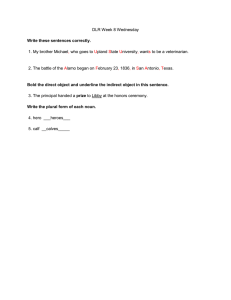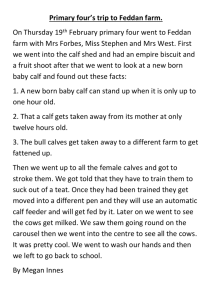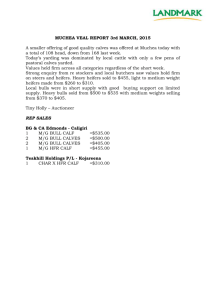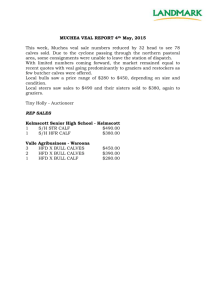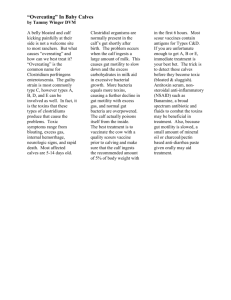Calf Management
advertisement
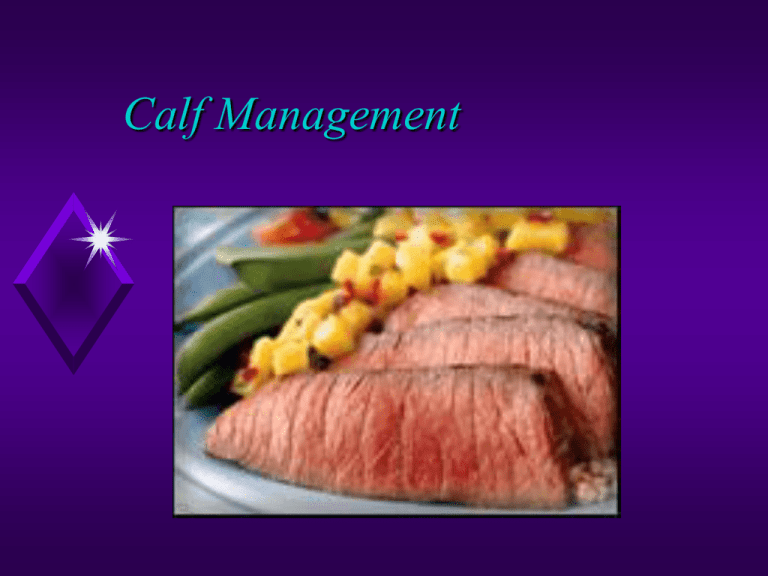
Calf Management Cow-Calf Management Definition- breeding of cows and raising of calves. commercial or purebred stockers facilities shelter fence working equip. and facilities From Birth to the Bank The most important item in the beef cattle industry is insuring that a cow weans a calf & is able to rebreed in a reasonable time Yet, first make sure the calf is born alive keep the calf alive and healthy to weaning provide favorable environment to manage the calf at weaning to reduce stress market the calf to its advantage Keys to profitable production of calves Provide adequate forage common causes of inadequate forage is overgrazing and poor stocking rate Care at calving Dystocia Use a maternity pasture calving shed, clean pasture provide assistance only when needed Calf Management 1/2 the calf loss occurs at calving most of the trouble is with heifers size and weight is important, not age breed to easy calving bulls Immunization Vac 45 program Growth Promotants- ralgro, synovex, compudose, etc. Feeding and Management of Calves Orphans whole Early milk, replacer, or whole with a starter Weaning Creep Feeding Replacement heifers Calf Management Management Practices Identification Weaning castration vaccinations/ dehorning implanting immunization Calf Management creep-feeding weaning management / pre-conditioning backgrounding Backgrounding - feeding and managing calves for 45 + days after weaning in order to be more healthy and bunk ready Pre-conditioning- a way of preparing a calf to withstand the stress and rigors of weaning Calf Management Pre-conditioning use minimum excitement work early (dehorn) wean 30 days early creep vaccinate control parasites health certification Dehorning, Castration and Identification Dehorning What is dehorning? process of removing or preventing the growth of horns. Why? improve appearance reduce injuries increase feeder space improve value. Two methods non-invasive invasive Restraint Very important Remember safety Restrain head Non-Invasive Bloodless Young animals Types Chemical Hot iron paste Invasive Blood flow Older animals Involves cutting or scooping the horn off of the animals skull. Types Barnes dehorner Scoop dehorner Keystone dehorner Reasons for dehorning Less barn, shed or feeding space less injuries easier to handle feedlots prefer dehorned cattle sometimes bring more money Disadvantages sets the animal back due to stress cost and labor as well as equipment death loss due to bleeding disease spreading scurrs may occur if not properly done Time to dehorn genetically calves, early as possible older cattle, colder weather Dehorning yearlings or older clippers, saw or surgical wire Clippers restrain the animal stand on the opposite side of the head from the horn to be removed spread the clippers open and place over the horn with the bevel next to the head. remove 1/4 “of the hide and tissue below the base of the horn Clippers advantages fast neat job disadvantages severe bleeding danger of cracking the skull Saw restrain the animal stand in front of the head and a little to one side saw into the skull removing 1/4” of hide and hair if anesthetic is used, use a 1”needle and place in the hollow spot above the eye Saw Advantages smooth job less bleeding than clippers Disadvantages much slower Surgical Wire cut the wire at arm span length restrain the animal place the wire at the base and back side of the horn start with short strokes until wire is imbeded use long smooth stroke to remove the horn Surgical Wire advantages smooth job less bleeding less set back disadvantages cost of the wire slow may need more than one piece of wire/animal Control of Hemorrhage perform dehorning early in the morning handle quietly as possible use forceps or hemostats to pull out the veins or use a hot iron to sear them stuff cotton in the hole use sterile equipment never dehorn when cows are eating sweet clover Dehorning calves polled bulls chemicals bell irons tube spoon barnes elastrator Chemicals basic substance such as KOH or NaOH restrain the animal remove hair around the button scrape button so that it is raw put ring of mineral oil around base of button apply chemical on button in liquid, paste, or stick form Tube different sizes Tube restrain the animal place the tube over the horn start at clockwise motion and push get below the tissue and pry out Spoon restrain the animal cut skin with spoon with back and forth motion and get below the tissue gouge it out much more slowly and causes more bleeding Hot Iron (Bell Iron) restrain the animal place iron over horn and press with rotating motion when the entire circle around the button is not brown in color, quit button will fall off in a couple weeks Barnes type secure the animal place the barnes over the horn at the slope of the head press down and quickly spread the handles adv. - fast, can dehorn larger calves disadv. - more bleeding, danger of infection and easier to make slips Castration Inactivation of primary sex organs for the male the younger the better methods: surgical, emasculator (burdizzo), elastrators, ethiopian style Castration What is castration? process of removing the testicles from a male. Why? prevent mating or fighting, improve carcass quality gentle them Two Methods Non-invasive Invasive Restraint Calves On side Older In bull calves chute Young On lambs and kids back Assistant’s arms V-shaped table Non-invasive Bloodless Tetanus antitoxin Crimps or contracts the blood vessels and spermatic cord resulting in loss of blood supply. Young calves or weanlings Types: Burdizzo Elastrator Calicrate bander Short-scrotumed Chemical castration Burdizzo Elastrator Calicrate smart bander Invasive Blood flow Sanitation is key Do not reach into the wound because it could cause infection Types: Knife/Scalpel Emasculator Knife Scalpel Emasculator Surgical Method restrain the animal examine the calf to see if testes have descended in to the scrotum disinfect equipment, hands, and scrotum grab the end of the scrotum with one hand and pull down. cut off the lower 1/3 of the scrotum surgical cont. pull testicles down one at a time / scrape if necessary trim excess fat and membrane carefully disinfect the area again Incision method is performed much the same way, but make an incision on each side of the scrotum first, then pull down each testicle through the incision Burdizzo restrain the animal do one at a time push teste down into scrotum and over to the side place the lips of the instrument over the cord 1/2 the distance between the teste and abdomen push handles together until the cord is crushed Elastrators bloodless castration method restrain the animal place the rubber band over the prongs spread the rubber band and push both testes down through it release the band above the testes check later for the scrotum to fall off disinfect Animal Identification Systems Identification Systems • Branding cattle • Ear Tagging cattle goats • Ear Notching swine • Tattooing cattle rabbits Branding Used mainly for cattle Two types Freeze Branding Hot Iron Branding Uses a metal instrument to burn or freeze a mark on the animal’s hide Originally used to show ownership Angle Brand System Angle Brand System What would be the number of this animal? Answer: 95 Angle Brand System Answer: What would be the number of this animal? 140 Angle Brand System 120 What would be the angle brand of this animal? Answer: Ear Tagging Use special pliers to attach pieces with numbers on them Easy to read from the front view Not permanent Can be lost or removed Ear Tagging Tattooing Uses a special tool to put inked numbers in an animal’s skin Most commonly found in the ear Can be used on the lips or other locations Permanent Simple and relatively painless Hard to read from a distance Tatooing Tatooing Ownership ID- Branding Branding - hot iron Chemicals Cold Branding - freeze Branding heat the irons to red hot restrain the animal place brand on hide check it until the surface of the brand is a shoe brown color selection of the brand should be simple and ventilated with the face smooth Fluid Branding uses potash or acids kills the hair follicles must be more careful because their is more room for accidents and error to animals and humans Freeze Branding super cold iron will burn dry ice and alcohol or liquid nitrogen or spray can restrain the animal clip the brand area clean the area and place irons to get cold place iron firmly until the area is sl. Harden Usually 50 seconds for dry ice /alcohol method 25-30 seconds for liquid nitrogen 3-4 weeks hair will grow back Tatooing Rotary type- nos. are on a roller Standard type- nos. are loose secure the calf clean the ear check the numbers place the instrument between the first and second ribs of the ear and clamp down place ink on the ear Other Methods of ID Eartags Horn Branding Earmarking Wattles - cutting a strip on the jawbone and letting it hang down Dewlaps - cut a strip on the brisket Buds - cutting on incision through the nose
